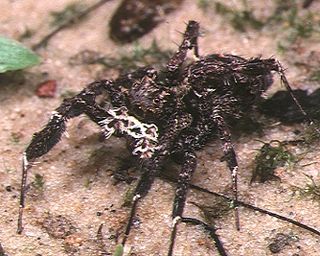
Myrmarachne is a genus of ant-mimicking jumping spiders that was first described by W. S. MacLeay in 1839. They are commonly called ant-mimicking spiders, but they are not the only spiders that have this attribute. The name is a combination of Ancient Greek μύρμηξ, meaning "ant", and ἀράχνη, meaning "spider".

Afraflacilla is a genus of the spider family Salticidae. Most species are distributed in Eastern to Northern Africa and Australia, with two species found in Europe. This genus was for a time included in the genus Pseudicius, and the boundaries between both genera are disputed. In 2016 Jerzy Prószyński erected the genus Psenuc for some borderline species. The name Afraflacilla is combined from Africa, where most earlier described species were found, and FlacillaSimon, 1901, an obsolete salticid genus now called FlacillulaStrand, 1932. This genus name is in turn derived from Aelia Flaccilla, wife of Roman Emperor Theodosius I. Afraflacilla, Pseudicius, Festucula and Marchena are close relatives and form a monophyletic group.
Bathippus is a genus of jumping spiders.
Colyttus is a genus of Asian jumping spiders that was first described by Tamerlan Thorell in 1891. C. lehtinen is named in honor of Finnish arachnologist Pekka T. Lehtinen.

Epeus is a genus of the spider family Salticidae. They are often found on broad-leaved plants or shrubs of rain forest, or in gardens of Southeast Asia.
Erasinus is a genus of the spider family Salticidae.

Hyllus is a genus of the spider family Salticidae. Most species occur in Africa and Madagascar, with many in Australasia and north to India. H. insularis is found in Greece and Iran, but it is considered misplaced in this genus, and is now Evarcha insularis.

Mantius is a spider genus of the jumping spider family, Salticidae.

Margaromma is a spider genus of the jumping spider family, Salticidae. The eight described species occur mostly in Australia and New Zealand, with several other species on Pacific islands. One species is found in Cameroon.
Microhasarius is a spider genus of the jumping spider family, Salticidae.

Pancorius is a genus of Asian jumping spiders that was first described by Eugène Louis Simon in 1902. They are similar to Hyllus.

Telamonia is a genus of jumping spiders that was first described by Tamerlan Thorell in 1887. They are colorful spiders, with patterns that vary considerably between sexes and species. Two longitudinal stripes along the abdomen are common, and the carapace is often colored. They have a slender opisthosoma and long legs.

Thiania is a genus of jumping spiders that was first described by Carl Ludwig Koch in 1846.

Viciria is a genus of jumping spiders that was first described by Tamerlan Thorell in 1877.

The Spartaeinae are a subfamily of the spider family Salticidae. The subfamily was established by Fred R. Wanless in 1984 to include the groups Boetheae, Cocaleae, Lineae, Codeteae and Cyrbeae, which in turn were defined by Eugène Simon.

Euophryini is a tribe of jumping spiders. Most spiders in this tribe have a spiral embolus that faces ventrally.

Afraflacilla braunsi is a species of jumping spider in the genus Afraflacilla. First found in South Africa, the spider was subsequently observed living in Saudi Arabia, Turkmenistan, the United Arab Emirates and Yemen, although it is likely to have a wider distribution. First described in 1903 by George and Elizabeth Peckham, it was originally allocated to the genus Pseudicius with the name Pseudicius braunsii. After being renamed Icius braunsi in 1987, it was finally given its current name by Jerzy Prószyński in 2017. Pseudicius tripunctatus, now called Afraflacilla tripunctatus, is a synonym.
Neaetha maxima is a species of jumping spider in the genus Neaetha that lives in Ivory Coast and Nigeria. It was first described in 2011 by Wanda Wesołowska & Anthony Russell-Smith based on a holotype found near Ibadan. Only the female has been described. The spider is atypically large, over 10 mm (0.39 in) long, which is reflected in the species name. The genus name can be translated new aspect. It has a light brown carapace and yellow-white abdomen, with orange-brown legs. The epigyne has a distinctive central pocket and wide copulatory ducts.
Neaetha wesolowskae is a species of jumping spider in the genus Neaetha that is endemic to Thailand. The Neaetha spider that has been found most easterly, it lives in rainforests. First described in 2020 by Barbara Patoleta & Marek Żabka, the spider is named for the Polish arachnologist Wanda Wesołowska. It is small with a brown carapace between 0.86 and 1.49 mm in length and an abdomen that is between 0.97 and 1.2 mm long. The female is smaller than the male and has a pattern of spots rather than lines on its abdomen. The female is hard to tell from other members of the genus but can be differentiated by its copulatory organs. Its epigyne has ovoid, rather than crescent-shaped, copulatory openings and spermathecae that are separated rather than lying together. The male has an embolus that is unusually crescent-shaped.











